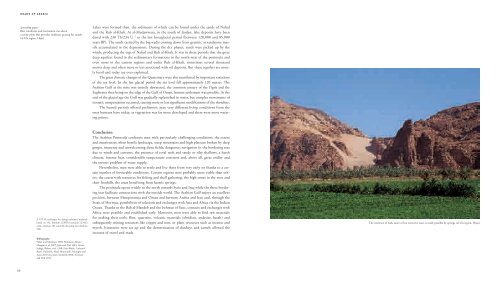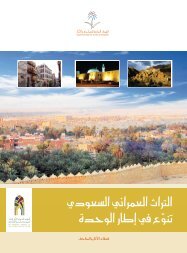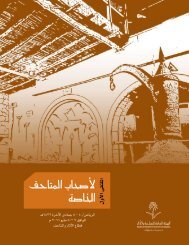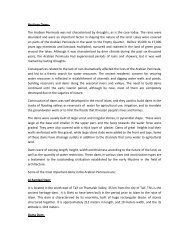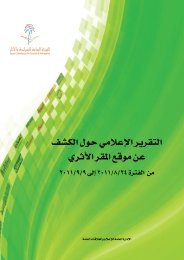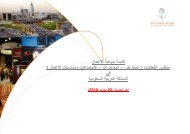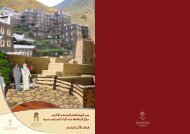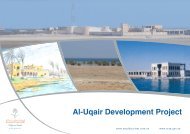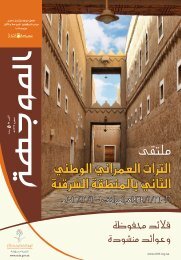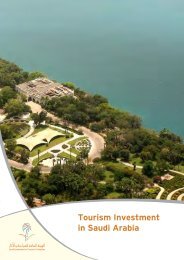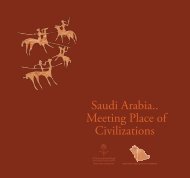Roads of Arabia
Roads of Arabia
Roads of Arabia
You also want an ePaper? Increase the reach of your titles
YUMPU automatically turns print PDFs into web optimized ePapers that Google loves.
02bis (08) Arabie US p54-69_BAT.qxd 23/06/10 19:38 Page 68<br />
ROADS OF ARABIA<br />
(preceding pages)<br />
Bare ruiniform rock formations rise above<br />
a sandy plain that provides moderate grazing for camels<br />
(al-Ula region, Hijaz)<br />
Lakes were formed then, the sediments <strong>of</strong> which can be found under the sands <strong>of</strong> Nafud<br />
and the Rub al-Khali. At al-Mudawwara, in the south <strong>of</strong> Jordan, lake deposits have been<br />
dated with 230 Th/234 U 2 to the last Interglacial period (between 120,000 and 85,000<br />
years BP). The sands carried by the big wadis coming down from granitic or sandstone massifs<br />
accumulated in the depressions. During the dry phases, sands were picked up by the<br />
winds, producing the ergs <strong>of</strong> Nafud and Rub al-Khali. It was in these periods that the great<br />
deep aquifers found in the sedimentary formations in the north-west <strong>of</strong> the peninsula and<br />
even more in the eastern regions and under Rub al-Khali, sometimes several thousand<br />
metres deep and <strong>of</strong>ten more or less associated with oil deposits. But these aquifers are mostly<br />
fossil and today are over-exploited.<br />
The great climatic changes <strong>of</strong> the Quaternary were also manifested by important variations<br />
<strong>of</strong> the sea level. In the last glacial period the sea level fell approximately 120 metres. The<br />
<strong>Arabia</strong>n Gulf at the time was entirely dewatered, the common estuary <strong>of</strong> the Tigris and the<br />
Euphrates then being on the edge <strong>of</strong> the Gulf <strong>of</strong> Oman, human settlement was possible. At the<br />
end <strong>of</strong> the glacial age the Gulf was gradually replenished in water, but complex movements <strong>of</strong><br />
isostatic compensation occurred, causing more or less significant modifications <strong>of</strong> the shoreline.<br />
The humid periods <strong>of</strong>fered prehistoric man very different living conditions from the<br />
ones humans have today, as vegetation was far more developed and there were more watering<br />
points.<br />
2. U/TH: technique for dating carbonate materials<br />
based on the thorium (230Th)-uranium (234U)<br />
ratio, uranium 234 naturally decaying into thorium<br />
230.<br />
Bibliography:<br />
Fisher and Membery 1998; Fleitmann, Burns,<br />
Mangini et al. 2007; Jado and Zötl 1984; Lézine,<br />
Saliège, Robert et al. 1998; Petit-Maire, Carbonel,<br />
Reyss, Sanlaville, Abed, Bourrouilh, Fontugne and<br />
Yasin 2010 (in press); Sanlaville 2000; Al-Sayari<br />
and Zötl 1978.<br />
Conclusion<br />
The <strong>Arabia</strong>n Peninsula confronts man with particularly challenging conditions: the extent<br />
and massiveness; <strong>of</strong>ten hostile landscape, steep mountains and high plateaus broken by deep<br />
gorges, immense and unwelcoming dune fields; dangerous navigation in the bordering seas<br />
due to winds and currents, the presence <strong>of</strong> coral reefs and sandy or silty shallows; a harsh<br />
climate, intense heat, considerable temperature contrasts and, above all, great aridity and<br />
the serious problem <strong>of</strong> water supply.<br />
Nevertheless, men were able to settle and live there from very early on thanks to a certain<br />
number <strong>of</strong> favourable conditions. Certain regions were probably more viable than others:<br />
the coasts with resources for fishing and shell gathering, the high zones in the west and<br />
their foothills, the areas benefiting from karstic springs.<br />
The peninsula opens widely to the north towards Syria and Iraq while the three bordering<br />
seas facilitate connections with the outside world. The <strong>Arabia</strong>n Gulf enjoys an excellent<br />
position, between Mesopotamia and Oman and between <strong>Arabia</strong> and Iran and, through the<br />
Strait <strong>of</strong> Hormuz, possibilities <strong>of</strong> relations and exchanges with Asia and Africa via the Indian<br />
Ocean. Thanks to the Bab al-Mandeb and the Isthmus <strong>of</strong> Suez, contacts and exchanges with<br />
Africa were possible and established early. Moreover, men were able to find raw materials<br />
for making their tools: flint, quartzite, volcanic materials (obsidian, andesite, basalt) and<br />
subsequently mining resources like copper and iron, or plant resources such as incense and<br />
myrrh. Itineraries were set up and the domestication <strong>of</strong> donkeys and camels allowed the<br />
increase <strong>of</strong> travel and trade.<br />
The existence <strong>of</strong> lush, more or less extensive oases is made possible by springs (al-Ula region, Hijaz)<br />
68


